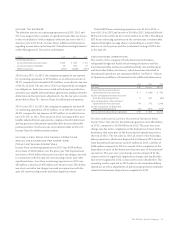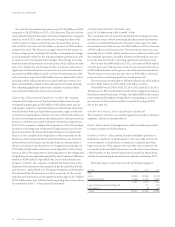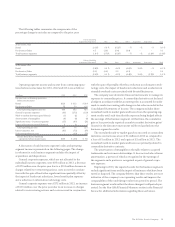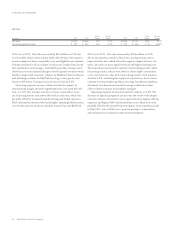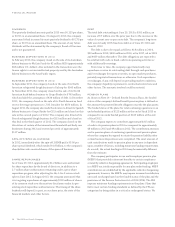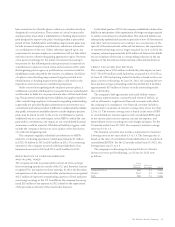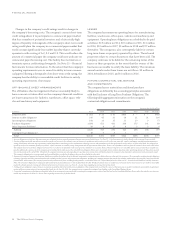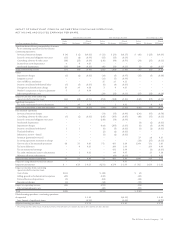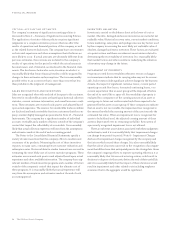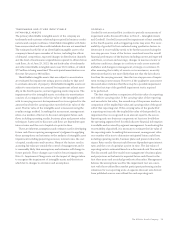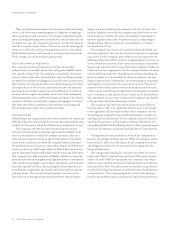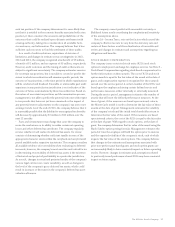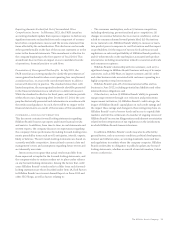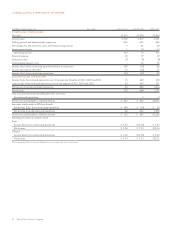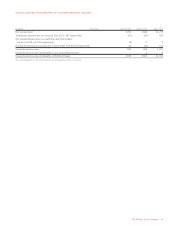Sara Lee 2013 Annual Report Download - page 23
Download and view the complete annual report
Please find page 23 of the 2013 Sara Lee annual report below. You can navigate through the pages in the report by either clicking on the pages listed below, or by using the keyword search tool below to find specific information within the annual report.The Hillshire Brands Company 21
GUARANTEES
The company is a party to a variety of agreements under which it
may be obligated to indemnify a third party with respect to certain
matters. Typically, these obligations arise as a result of contracts
entered into by the company under which the company agrees to
indemnify a third party against losses arising from a breach of repre-
sentations and covenants related to such matters as title to assets
sold, the collectibility of receivables, specified environmental matters,
lease obligations assumed and certain tax matters. In each of these
circumstances, payment by the company is conditioned on the other
party making a claim pursuant to the procedures specified in the
contract. These procedures allow the company to challenge the other
party’s claims. In addition, the company’s obligations under these
agreements may be limited in terms of time and/or amount, and in
some cases the company may have recourse against third parties for
certain payments made by the company. It is not possible to predict
the maximum potential amount of future payments under certain
of these agreements, due to the conditional nature of the company’s
obligations and the unique facts and circumstances involved in each
particular agreement. Historically, payments made by the company
under these agreements have not had a material effect on the com-
pany’s business, financial condition or results of operations. The
company believes that if it were to incur a loss in any of these matters,
such loss would not have a material effect on the company’s business,
financial condition or results of operations.
The material guarantees for which the maximum potential
amount of future payments can be determined, include the com-
pany’s contingent liability on leases on property operated by others
that is described above, and the company’s guarantees of certain
third-party debt. These debt guarantees require the company to
make payments under specific debt arrangements in the event that
the third parties default on their debt obligations. The maximum
potential amount of future payments that the company could be
required to make in the event that these third parties default on
their debt obligations is approximately $16 million. At the present
time, the company does not believe it is probable that any of these
third parties will default on the amount subject to guarantee.
RISK MANAGEMENT
CHALLENGES AND RISKS
As a consumer products company, we face certain risks and challenges
that impact our business and financial performance. The risks and
challenges described below have impacted our performance and are
likely to impact our future results as well.
The food and consumer products businesses are highly competitive.
In many product categories, we compete not only with widely adver-
tised branded products, but also with private label products that are
generally sold at lower prices. As a result, from time to time, we may
need to reduce the prices for some of our products to respond to
competitive pressures. Economic uncertainty may result in increased
pressure to reduce the prices for some of our products, limit our
ability to increase or maintain prices or lead to a continued shift
toward private label products. Any reduction in prices or our inability
to increase prices when raw material costs increase could negatively
impact profit margins and the overall profitability of our reporting
units, which could potentially trigger a goodwill impairment.
Commodity prices directly impact our business because of their
effect on the cost of raw materials used to make our products and the
cost of inputs to manufacture, package and ship our products. Many
of the commodities we use, including pork, beef, poultry, packaging,
energy, cheese, fruit, seasoning blends, flour and sugar have experi-
enced price volatility due to factors beyond our control. The company’s
objective is to offset commodity price increases with pricing actions and
to offset any operating cost increases with continuous improvement
savings. During 2013, commodity costs, excluding mark-to-market
derivative gains/losses, decreased over the prior year. The benefit of
lower commodity costs was partially offset by price reductions. The
company expects commodity costs to increase in 2014.
In June 2012, the company announced that it expected to
deliver $100 million of savings between 2013 and 2015. At that time,
initiatives to deliver $65 million of savings had been identified. The
company has now identified the remaining $35 million of cost savings,
as well as approximately $45 million of additional savings expected
through 2016. The cost savings are expected to result from improved
revenue management, supply chain and support processes. The
company expects to recognize cash charges of approximately $80 mil-
lion to $100 million between 2013 and 2016. Non-cash charges may
also be recognized as the initiatives are implemented. The company
recognized approximately $16 million of cash charges in 2013 related
to these new cost savings initiatives. When fully implemented,
these initiatives are expected to deliver ongoing annual savings
of $80 million.
INTEREST RATE AND COMMODITY RISKS
To mitigate the risk from interest rate and commodity price
fluctuations, the company may enter into various hedging transac-
tions that have been authorized pursuant to the company’s policies
and procedures. The company does not use financial instruments
for trading purposes and is not a party to any leveraged derivatives.
Interest Rates The company has used interest rate swaps to modify
its exposure to interest rate movements, reduce borrowing costs and
to lock in interest rates on anticipated debt issuances. Interest rate
risk management is accomplished through the use of swaps to modify
interest payments under these instruments. As of the end of 2013,
the company does not have any interest rate swaps outstanding as
it has no significant exposure to changing interest rates on our long-
term debt because the interest rate is fixed on 100% of the company’s


